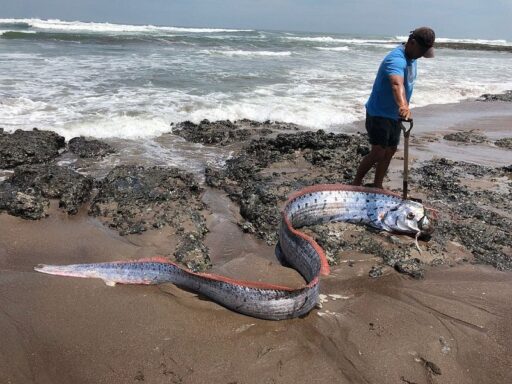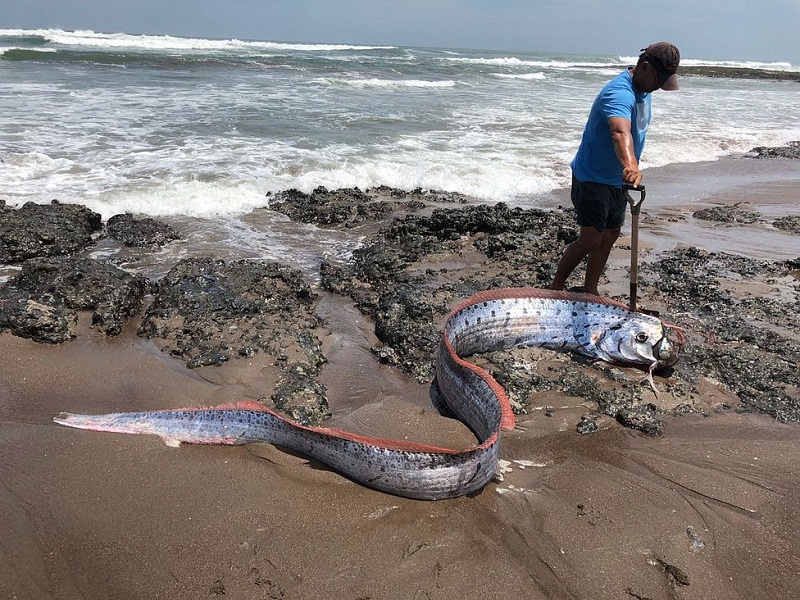Introduction to Oarfish and Giant Oarfish
Humans always have the curiosity to search and research what they find. According to NOAA’s National Geophysical Data Center, there are estimated water in the ocean is around 1,335,000,000 cubic kilometers (321,003,271 cubic miles). In this Deep sea, there are several creatures alive, scary but still interesting, due to their natural abilities.
Oarfish are one of them, Oarfish came in the category of the world’s largest fish which is the prior counterpart of this creature. This animal is among the most fascinating and unique species in the marine world. Distinguished by their elongated, ribbon-like bodies, they can reach remarkable lengths, with typical oarfish growing up to 11 meters and giant oarfish sometimes cross this measurement. Their physical appearance is striking, characterized by a silvery body adorned with a long, red dorsal fin that runs the length of their spine, giving them a mythical quality.
These fish inhabit the deep-sea environments of the world’s oceans, usually residing at depths ranging from 200 to 1000 meters. This preference for the deep-sea habitat makes them relatively elusive and contributes to the air of mystery that surrounds them. Oarfish are rarely seen by humans, often only coming to the surface when they are sick or dying, which has historically fueled numerous marine legends and myths.
The diet of oarfish primarily consists of plankton, small crustaceans, and other tiny marine organisms, which they filter from the water using their gill rakers. Their reproduction system is not well-documented due to their deep-sea lifestyle, but still, it’s believed that oarfish release eggs and sperm into the water, where outside fertilization occurs. The life cycle of these creatures remains largely unknown, though it is thought that they may live for several decades.
Despite their daunting size and unusual appearance, oarfish have few natural predators. Their deep-sea habitat protects them from many potential threats, although they are sometimes preyed upon by larger marine predators like sharks. Human activities, such as deep-sea fishing and habitat disruption, pose potential threats to their population. Conservation efforts are limited due to the scarcity of encounters with these enigmatic fish, but they remain a subject of keen interest and study in marine biology.
Oarfish Sightings and Earthquake Predictions
The belief that oarfish sightings are harbingers of earthquakes is deeply rooted in various cultural traditions, particularly in Japan. Known as ‘Ryugu no tsukai,’ or ‘messengers from the sea god’s palace,’ oarfish have long been considered omens of seismic activity. This folklore has persisted for centuries, with numerous accounts of oarfish appearing before significant earthquakes. The 2011 Tohoku earthquake and tsunami, a devastating event in recent history, was preceded by several oarfish sightings, reinforcing the belief for many that these deep-sea creatures can predict seismic events.
Documented cases linking oarfish sightings to earthquakes are not limited to Japan. Reports from around the world have noted similar patterns; however, the scientific community remains cautious about drawing definitive conclusions. While the anecdotal evidence is compelling, the need for empirical research is paramount. Some scientists propose that oarfish may be sensitive to the subtle changes in their environment that precede earthquakes. These changes could include shifts in water pressure, alterations in ocean currents, or even the vibrations caused by tectonic movements.
Research into these phenomena is ongoing. One theory suggests that the deep-sea habitat of the oarfish, which extends to depths of 200 to 1,000 meters, makes them particularly attuned to changes that occur before an earthquake. As these creatures are not frequently observed near the surface, their appearance in shallower waters could indicate an unusual disturbance in their environment. This hypothesis aligns with the idea that oarfish, like some other marine species, might respond to seismic precursors by moving to less affected areas.
Despite the intriguing nature of these observations, the scientific community calls for more rigorous studies to validate any direct correlation between oarfish sightings and earthquake predictions. While the folklore provides fascinating anecdotal evidence, it is essential to approach the topic with a balanced perspective. Further research is necessary to determine whether these deep-sea giants can indeed serve as reliable indicators of seismic activity, or if their appearances before earthquakes are merely coincidental.





